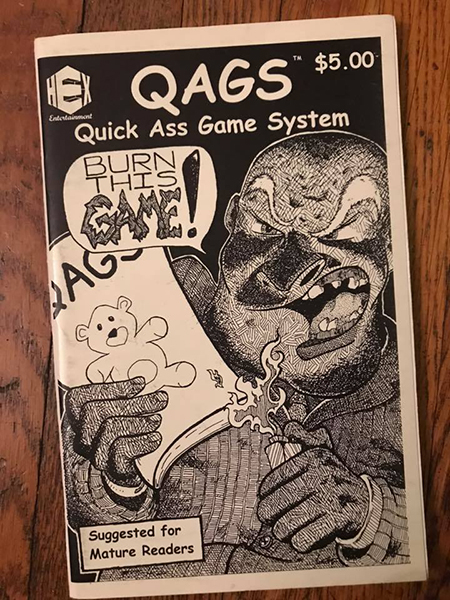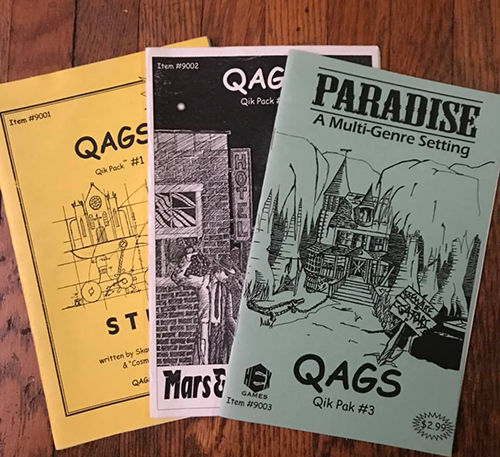10 Things You Maybe Don’t Know About the Origins of Hex Games
Last weekend the staff of Hex Games, including me, went to Archon 42 in Collinsville, where we celebrated the 20th anniversary of the publication of QAGS. This occasion inspired lots of reminiscing about the early days of Hex, which in turn inspired this list.
In the early days of Hex, we wanted to build a mythology around ourselves, so we wrote staff bios that were filled with lies, and we wrote multiple, contradictory accounts of how the company got started. It was difficult to figure out the truth; we thought this was hilarious, but people who just wanted to know who we were found it annoying. Maybe they had a point. We’re older now, so all ten items in this list are true.
1. In 1997 Scott, a college student who would be graduating in a few months, had the idea that he and his friends should work together to publish their various creative endeavors. Scott’s original pitch was that he, Steve, Dale, and me would form a company called Upstart. It turned out that name had already been taken, so instead we founded a company called Hex Entertainment. The idea was that we would start with games, and branch out into comics and other media. For our first release, we decided on QAGS, a game system Steve had created, because we thought it would be quick and easy to write.
2. Writing QAGS took a year. But it was a very productive year, in which Steve and I learned how to sit down and, sentence by sentence, co-write a book. Dale was there at the beginning, but soon drifted away; this wasn’t a surprise, since he lived in another city. Lots of our friends chipped in, in one way or another, popping into Steve’s apartment and hanging out while we labored over the text. After we finished the first draft, we shared it, got feedback, and revised.
3. When we decided to write QAGS, we felt like we could probably fit all the rules on a single sheet of paper, so we had to find some way to expand it into a book. We settled on including lots of jokes. Back then many RPG books were written in a dry, informative style; we wanted something that would keep the reader entertained. Honestly, though, we overdid it—we would actually say things like, “There’s a paragraph here with no jokes, we need to add one in.” The finished text had so many jokes that they got in the way of understanding the (simple) rules.
4. In QAGS, you want to roll high without going over. It’s not that you want to roll as close to your number as possible; percentages don’t matter. The higher the number of your success, the better. This has often been misunderstood.
5. The artwork in QAGS comes mostly from a couple of pages of random drawings that Dale and I did, some of which was intended for publication and some of which was not. We weren’t paying for art, though, so we took what we could get. Steve’s then-roommate Robert gave us a stack of drawings. Robert was young and looking to get published, and we were happy to give him his first big break. Shortly after QAGS came out, Robert decided he was more interested in writing than drawing. He went on to create a comic book series The Walking Dead which was, in some ways, even more successful than QAGS.
6. Early on, we bought a teddy bear, named him Mr. Pookums, and made him the president of Hex Games. Just like all the successful companies do.
7. Dale drew the QAGS cover. We recruited a fellow we gamed with named Robert (not the Walking Dead guy) to do the layout. He was an art teacher, and for some reason we met in his classroom, where we huddled around his computer and watched him lay out the book. We chose Comic Sans for the font, because it was the 90s, and we didn’t know any better. Robert also designed and drew the Hex logo, which is still in use to this day.
8. While we were working on the book, we were also marketing QAGS. We set up a website, with the extremely catchy address http://www.mindspring.com/~sejohnson, and filled it with in-jokes and nonsense. So much nonsense. Steve and I ran QAGS games at local conventions. Some of the earliest games we ran were Scooby-Doo Meets the X-Files, Dukes of Hazzard Meets the Invisibles, ViewAskewniverse, and Qerth. The games went really well, which motivated us to get the book done.
9. QAGS was a charming black-and-white digest-sized book, that looks like we made it at Kinko’s, but we used a local printing company. After all our hard work it was amazing to finally have the finished product in our hands. We released it in 1998, selling it at local stores in Lexington, and through the website. There was a lot of excited talk about this new “e-commerce,” back then. Sales were pretty good . . . good enough to print up more books, which was what we had hoped for.
10. We decided to call our supplements Qik Paks. Scott and our friend Ray co-wrote the first Qik Pak, called Stuff. This was followed by Mars and Venus at War, by me, and Paradise, by Steve. Stuff was an equipment guide, Paradise was a setting guide and Mars and Venuswas an adventure. I didn’t realize, until I looked just now, that all three of those Qik Paks came out in 2000. That means we released QAGS in 1998, took a year off, and then released books every year since. To date, Hex has released over 60 products.

